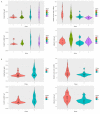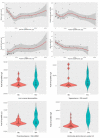Distinct phenotypes of multisystem inflammatory syndrome in children: a cohort study
- PMID: 37046304
- PMCID: PMC10092941
- DOI: 10.1186/s12969-023-00815-w
Distinct phenotypes of multisystem inflammatory syndrome in children: a cohort study
Abstract
Background: Multisystem inflammatory syndrome in children (MIS-C) is a severe disease with an unpredictable course and a substantial risk of cardiogenic shock. Our objectives were to (a) compare MIS-C phenotypes across the COVID-19 pandemic, (b) identify features associated with intensive care need and treatment with biologic agents.
Methods: Youth aged 0-18 years, fulfilling the World Health Organization case definition of MIS-C, and admitted to the Alberta Children's Hospital during the first four waves of the COVID-19 pandemic (May 2020-December 2021) were included in this cohort study. Demographic, clinical, biochemical, imaging, and treatment data were captured.
Results: Fifty-seven MIS-C patients (median age 6 years, range 0-17) were included. Thirty patients (53%) required intensive care. Patients in the third or fourth wave (indicated as phase 2 of the pandemic) presented with higher peak ferritin (µg/l, median (IQR) = 1134 (409-1806) vs. 370 (249-629), P = 0.001), NT-proBNP (ng/l, median (IQR) = 12,217 (3013-27,161) vs. 3213 (1216-8483), P = 0.02) and D-dimer (mg/l, median (IQR) = 4.81 (2.24-5.37) vs. 2.01 (1.27-3.34), P = 0.004) levels, and higher prevalence of liver enzyme abnormalities (n(%) = 17 (68) vs. 11 (34), P = 0.02), hypoalbuminemia (n(%) = 24 (100) vs. 25 (81), P = 0.03) and thrombocytopenia (n(%) 18 (72) vs. 11 (34), P = 0.007) compared to patients in the first two waves (phase 1). These patients had a higher need of non-invasive/mechanical ventilation (n(%) 4 (16) vs. 0 (0), P = 0.03). Unsupervised clustering analyses classified 47% of the patients in the correct wave and 74% in the correct phase of the pandemic. NT-proBNP was the only significant contributor to the need for intensive care in all applied multivariate regression models. Treatment with biologic agents was significantly associated with peak CRP (mg/l (median, IQR = 240.9 (132.9-319.4) vs. 155.8 (101.0-200.7), P = 0.02) and ferritin levels (µg/l, median (IQR) = 1380 (509-1753) vs. 473 (280-296)).
Conclusions: MIS-C patients in a later stage of the pandemic displayed a more severe phenotype, reflecting the impact of distinct SARS-CoV-2 variants. NT-proBNP emerged as the most crucial feature associated with intensive care need, underscoring the importance of monitoring.
Keywords: COVID-19; Cardiogenic shock; MIS-C; Pediatric intensive care; Phenotypes.
© 2023. The Author(s).
Conflict of interest statement
The authors declare that they have no competing interests.
Figures


Similar articles
-
Comparison of the course of multisystem inflammatory syndrome in children during different pandemic waves.Eur J Pediatr. 2023 Apr;182(4):1647-1656. doi: 10.1007/s00431-022-04790-4. Epub 2023 Jan 31. Eur J Pediatr. 2023. PMID: 36719477 Free PMC article.
-
Severe manifestations of SARS-CoV-2 in children and adolescents: from COVID-19 pneumonia to multisystem inflammatory syndrome: a multicentre study in pediatric intensive care units in Spain.Crit Care. 2020 Nov 26;24(1):666. doi: 10.1186/s13054-020-03332-4. Crit Care. 2020. PMID: 33243303 Free PMC article.
-
Severe clinical spectrum with high mortality in pediatric patients with COVID-19 and multisystem inflammatory syndrome.Clinics (Sao Paulo). 2020;75:e2209. doi: 10.6061/clinics/2020/e2209. Epub 2020 Aug 19. Clinics (Sao Paulo). 2020. PMID: 32844958 Free PMC article.
-
Clinicolaboratory Profile, Treatment, Intensive Care Needs, and Outcome of Pediatric Inflammatory Multisystem Syndrome Temporally Associated with SARS-CoV-2: A Systematic Review and Meta-analysis.J Pediatr Intensive Care. 2020 Nov 19;11(1):1-12. doi: 10.1055/s-0040-1719173. eCollection 2022 Mar. J Pediatr Intensive Care. 2020. PMID: 35178272 Free PMC article. Review.
-
Multisystem Inflammatory Syndrome in Children (MIS-C).Curr Allergy Asthma Rep. 2022 May;22(5):53-60. doi: 10.1007/s11882-022-01031-4. Epub 2022 Mar 22. Curr Allergy Asthma Rep. 2022. PMID: 35314921 Free PMC article. Review.
Cited by
-
Longitudinal Cardiac Evaluation of Children with Multisystem Inflammatory Syndrome (MIS-C) Following COVID-19 by Conventional and Speckle-Tracking Echocardiography.Pediatr Cardiol. 2024 Jun;45(5):1110-1119. doi: 10.1007/s00246-023-03375-8. Epub 2024 Feb 19. Pediatr Cardiol. 2024. PMID: 38372778 Free PMC article.
-
Infection, Dysbiosis and Inflammation Interplay in the COVID Era in Children.Int J Mol Sci. 2023 Jun 29;24(13):10874. doi: 10.3390/ijms241310874. Int J Mol Sci. 2023. PMID: 37446047 Free PMC article. Review.
References
-
- Ludvigsson JF, Wu Z, McGoogan JM, et al. Correspondence: children with Covid-19 in Pediatric Emergency Departments in Italy. JAMA. 2020;15(January):19–21.
MeSH terms
Substances
Supplementary concepts
LinkOut - more resources
Full Text Sources
Medical
Research Materials
Miscellaneous

